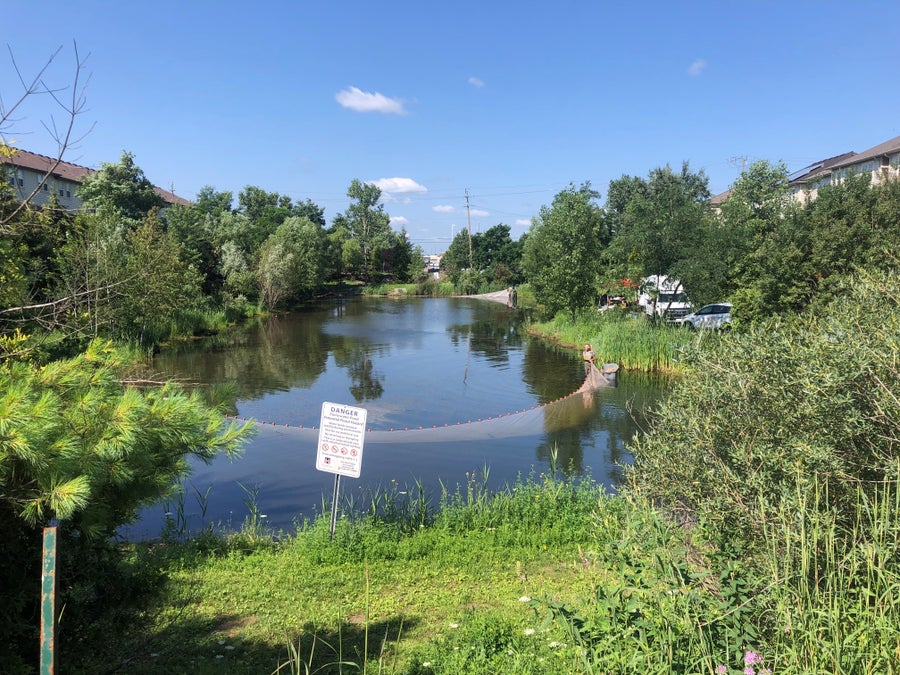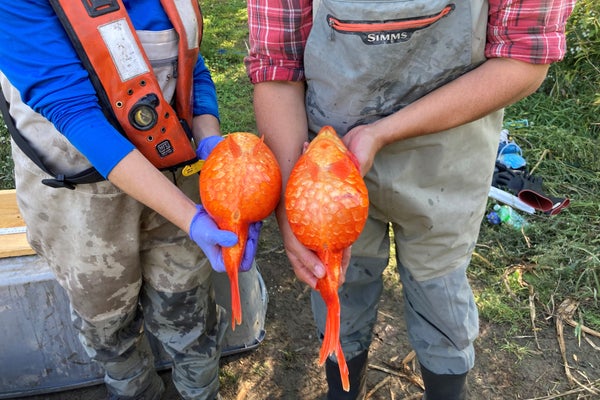Just west of Toronto last summer, startled biologists counted more than 20,000 goldfish in a single urban stormwater pond the size of two basketball courts. And the fish, probably descended from dumped pets, were not only thriving numerically—some had grown into three-pound behemoths. Cities around North America have increasingly been building such ponds in the past 40 years to capture rain and runoff, and invasive goldfish are flourishing in thousands of them.
Ecologists at the University of Toronto and the Fisheries and Oceans Canada (DFO) are now investigating if and how these ponds’ harsh, polluted environments are selecting for extra-tolerant fish—which might eventually manage to out-compete native species in the nearby Great Lakes. As Nicholas Mandrak, a University of Toronto Scarborough conservation biologist working on the project, puts it: “Are we creating these ‘superinvaders’ that are likely to have incrementally greater impacts in the wild under climate change?”
Goldfish originated in East Asia. They probably first made their way via ships’ ballast water to North American rivers and the Great Lakes, where Mandrak estimates that small, localized populations have survived for 150 years. They are a detrimental presence in any new habitat they enter, says Anthony Ricciardi, a professor of ecology and invasive species at McGill University, who has worked with Mandrak in the past but was not involved in the new research. For one thing, goldfish are messy eaters. They gulp mouthfuls of fine sediment from lake and river bottoms, swirl it around, spit out the dirt cloud and then suck in whatever food falls out. This uproots plants and makes water cloudy. Less light then filters through to aquatic plants, which may eventually die as a result. Through this destructive behavior, goldfish engineer their habitat in ways that make it worse for other species that catch prey by sight or depend on sunlight, Ricciardi says.
On supporting science journalism
If you're enjoying this article, consider supporting our award-winning journalism by subscribing. By purchasing a subscription you are helping to ensure the future of impactful stories about the discoveries and ideas shaping our world today.
Though invasive goldfish have had a long presence in North America, their populations in stormwater ponds and some harbors in the Great Lakes have sharply increased in the past decade—alongside a concurrent rise in urban stormwater pond construction. Biologists suspect that most stormwater pond goldfish were originally introduced by humans; it is unlikely that lake goldfish made their way upstream into these isolated pools. Most fish species cannot live in the harsh and unstable conditions of stormwater ponds, where water levels fluctuate frequently with rainfall. These ponds can also be low in oxygen and have relatively warm temperatures because of their shallow depth. But goldfish have evolved a special metabolic system that can sometimes enable them to survive up to five months without oxygen.

One of the stormwater ponds scientists investigated for signs of goldfish adapted to harsh water conditions. Credit: Christine Boston/Fisheries and Oceans Canada
Scientists worry this latter ability will give goldfish a competitive advantage over native species as global warming causes oxygen levels in lakes and rivers to decrease, says DFO fish production biologist Christine Boston. If that happens, and if urban pond fish get into natural wetlands, they could wreak even more havoc than the existing nonpond populations of goldfish. To find out more, Mandrak and his colleagues are comparing pond goldfish with wild Canadian goldfish populations under current conditions and under those expected from climate change.
Last summer the team tested the temperature tolerance of goldfish from two stormwater ponds. The researchers placed goldfish in water and slowly increased the temperature until the fish could not maintain an upright position, indicating they had reached their maximum heat tolerance. Mandrak is set to test goldfish from another 24 ponds this summer and to compare the overall tolerances of pond goldfish with those of wild populations in the Great Lakes. Eventually the team plans to identify the specific genes that regulate temperature tolerance and to determine whether they vary between wild and pond fish—which would be a sign that adaptation is occurring.
The project also aims to characterize stormwater pond environments. These ponds are usually less than six feet deep and tend to be relatively warm. They are often very salty because of runoff from winter road salt, and they frequently contain extra nutrients from fertilizer. The warm temperatures and elevated nutrient levels lead to low oxygen levels in the water, Boston says. She is also developing environmental DNA (eDNA) sampling methods to test for goldfish genetic material in small water samples. Knowing pond characteristics can help the DFO identify specific stormwater ponds as “high risk” goldfish habitats, and they can then quickly use eDNA samples to determine what species are present. If goldfish are detected, drainage into adjacent waterways could be blocked to reduce the chances of exceptionally tolerant fish entering the natural environment.
Future management of these potential superinvaders comes down to prevention, say experts, including Mandrak, Boston, Ricciardi and others. For example, signs could be placed around ponds to advise fish owners to return unwanted pets to the store or give them to a friend instead of dumping them. Beyond this public messaging, Boston says land developers and engineers may want to reconsider stormwater pond design to keep out goldfish and other invasive species. This might include building barriers between ponds and adjacent waterways or stocking ponds with goldfish predators such as largemouth bass (which are already native to the areas involved), Boston says.
Boston and other biologists are hoping to better understand the threat before it is too late for downstream native fish nurseries and wetlands. “Until we have completed the risk assessment,” Mandrak says, “we should do our best to make sure that those goldfish don’t get into the wild.”
